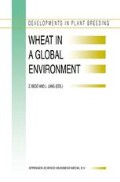Abstract
CIMMYT has recently established a program to screen and breed for resistance against root lesion nematode (RLN) (Pratylenchus thornei), the cereal cyst nematode (CCN) Complex (Heterodera spp.),and the soil-borne fungi, crown rot (CR) (Fusarium graminearum, Group 1) and common root rot (CRR) (Bipolaris sorokiniana (telemorph Cochliobolus sativus)). Initially, the targeted germplasm for resistance is screened intensively in the greenhouse, and those lines indicating the most promise are crossed. At the same time the resistances identified against RLN, CR and CRR are confirmed under field conditions.
At BC1F2 generation, 12 single spikes derived from different plants of favorable types are collected. Their seed (BC1F3) is then tested in the greenhouse, while at the same time a sample is also planted in the field. Progenies exhibiting resistance in the greenhouse test are then backcrossed again in the field and advanced.
To date greenhouse screening has identified new potential sources of resistance that include landraces, high-yielding CIMMYT wheats and synthetic hexaploid derivatives. These sources are currently being screened in the field to confirm their resistances.
Access this chapter
Tax calculation will be finalised at checkout
Purchases are for personal use only
Preview
Unable to display preview. Download preview PDF.
References
Bailey, K.L., Duczek, L.J. and Potts, D.A. (1997). Inoculation of seeds with Bipolaris sorokiniana and soil fumigation methods to determine wheat and barley tolerance and yield losses caused by common root rot. Can J. Plant. Sci., 77, 691–698.
Bekal, S., Jahier, J., Rivoal, R. (1998): Host responses of Triticeae to species of the cereal cyst nematode complex in relation to breeding resistant durum wheat. Fundam appl Nematol, 21, 359–370.
Dodman, R.L. and Wildermuth, G.B. (1987): Inoculation Methods for Assessing Resistance in Wheat to Crown Rot Caused by Fusarium graminearum Group 1. Aust. J Agric. Res., 38, 473–486.
Diehl, J.A., Tinline, R.D. and Kochhann, R.A. (1983): Perdas em trigo causadas pela podridao comum de raizes no Rio Grande do Sul, 1979–1981. Fitopatol Bras, 8, 507–511.
Dubin, H.J. and van Ginkel M. (1991): Status of wheat diseases and disease research in the warmer areas of the world. In: D.A. Saunders (ed.), Wheat for the nontraditional warm areas. CIMMYT, Mexico, 125–145.
Dubin, H.J. and Bimb, H.P. (1994): Studies of soil-borne diseases and foliar blights of wheat ant the National Wheat Research Experiment Station. Bairahawa, Nepal. Wheat Special Report No. 36. CIMMYT, Mexico.
Nicol, J.M., Davies, K.A. and Eastwood, R. (1998): AUS4930: A new source of resistance to Pratylenchus thornei in wheat. In: Proceedings of the 24`h International Nematology Symposium, 4–9`h August, 1998, Dundee, Scotland.
Nicol, J.M., Davies, K.A., Hancock. T.W. and Fisher, J.F. (1999): Yield loss Caused by Pratylenchus thornei on Wheat in South Australia. J. Nematology. 31, 367–376.
Nicol, J.M. (2000): Important Nematode Pests of Cereals. In: FAO (2000): Curtis, B.C. (ed.) Wheat Production and Improvement. FAO Plant Production and Protection Series.
Ibrahim, A.A.M., Al-Hazmi A.S., Al-Yahya F.A,and Alderfasi A.A. (1999): Damage potential and reproduction of Heterodera avenae on wheat and barley under Saudi field conditions. Nematology, 1, 625–630.
Magbool, M.A. (1988): Present status of research on plant-parasitic nematodes in cereals and forage legumes in Pakistan. In: M.C. Saxena, R.A. Sikora and J.P. Srivastava (eds.) Nematodes parasitic to cereals and legumes in temperate semiarid regions. ICARDA, Aleppo, Syria. 173–180.
Piening, L.J., Atkinson T.G., Horricks, J.S., Ledingham, R.J., Mills, J.T. and Tinline, R.D. (1976): Barley losses due to common root rot in the prairie provinces of Canada, 1970–1972. Can Plant Dis Surv, 56, 41–45.
Taheri, A., Hollamby, G.J. and Vanstone, V.A. (1994): Interaction between root lesion nematode, Pratylenchus neglectus (Rensch 1924) Chitwood and Oteifa 1952, and root rotting fungi of wheat. New Zealand Journal of Crop and Hort Sci, 22, 18 1185.
Tinline, R.D., Wildermuth, G.B. and Spurr D.T. (1988): Inoculum Density of Cochhobolus sativus in Soil and Common Root Rot of Wheat Cultivars in Queensland. Aust. J Agric. Res., 39, 569–577.
Van Berkum, J.A. and Seshadri A.R. (1970): Some important nematode problems in India. Xth International Nematology Symposium, Pescara, Italy, 136–137.
Ginkel, M., Trethowan, R. and Cukadar, B. (1998): A Guide to the CIMMYT Bread Wheat Program. Wheat Special Report No. 5. CIMMYT, Mexico, D.F., Mexico.
Wildermuth., G.B., Tinline, R.D and McNamara R.B. (1992): Assessment of Yield Loss Caused by Common Root Rot in Wheat Cultivars in Queensland. Aust. J. Agric. Res., 43, 43–58.
Wildermuth, G.B. (1994): Testing Wheat Seedlings for Resistance to Crown Rot Caused by Fusarium graminearum Group 1. Plant Diseas, e 78: 949–953.
Author information
Authors and Affiliations
Editor information
Editors and Affiliations
Rights and permissions
Copyright information
© 2001 Springer Science+Business Media Dordrecht
About this chapter
Cite this chapter
Nicol, J.M., Rivoal, R., Trethowan, R.M., Van Ginkel, M., Mergoum, M., Singh, R.P. (2001). Cimmyt’s Approach to Identify and Use Resistance to Nematodes and Soil-Borne Fungi, in Developing Superior Wheat Germplasm. In: Bedö, Z., Láng, L. (eds) Wheat in a Global Environment. Developments in Plant Breeding, vol 9. Springer, Dordrecht. https://doi.org/10.1007/978-94-017-3674-9_49
Download citation
DOI: https://doi.org/10.1007/978-94-017-3674-9_49
Publisher Name: Springer, Dordrecht
Print ISBN: 978-90-481-5618-4
Online ISBN: 978-94-017-3674-9
eBook Packages: Springer Book Archive

